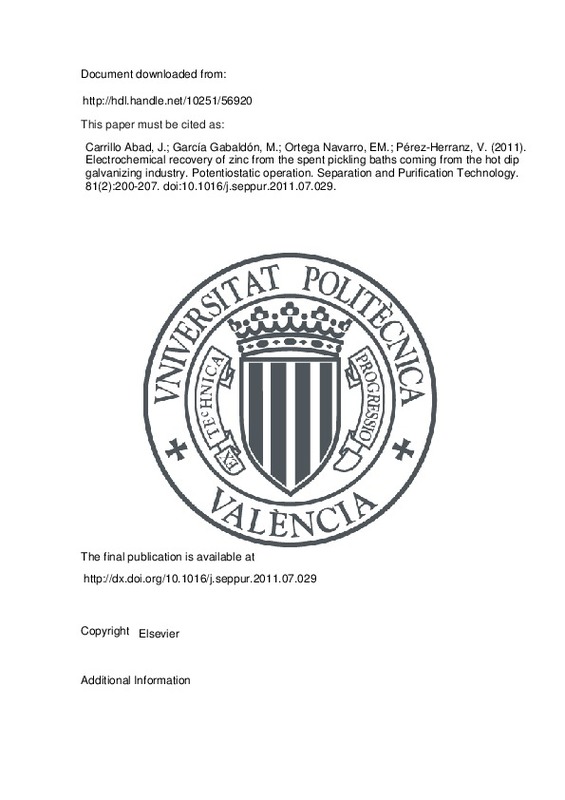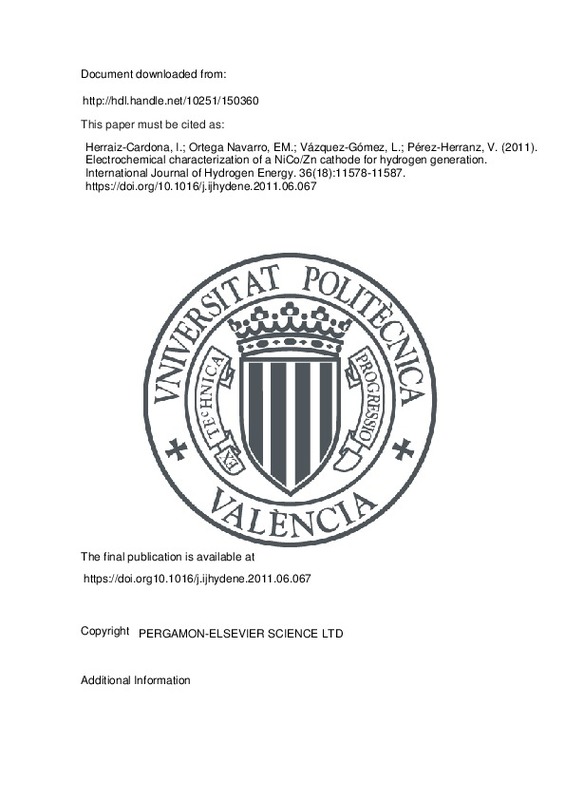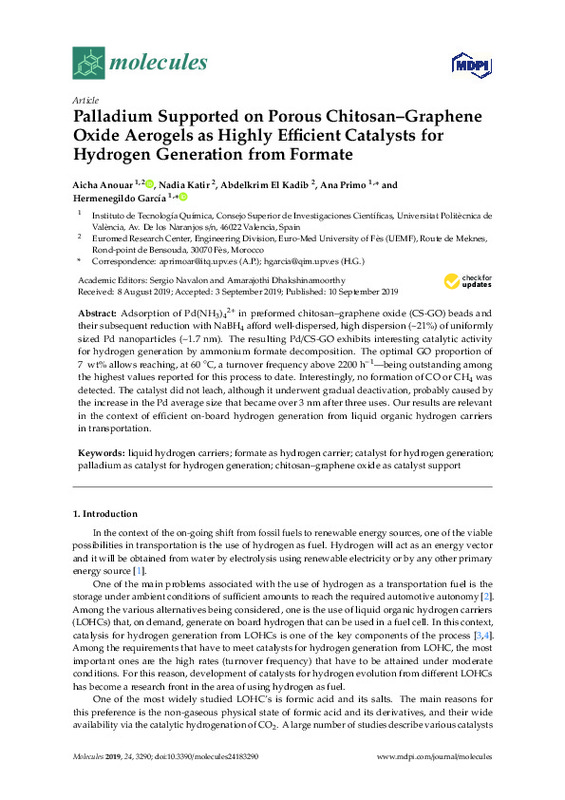JavaScript is disabled for your browser. Some features of this site may not work without it.
Buscar en RiuNet
Listar
Mi cuenta
Estadísticas
Ayuda RiuNet
Admin. UPV
Electrochemical recovery of zinc from the spent pickling baths coming from the hot dip galvanizing industry. Potentiostatic operation
Mostrar el registro sencillo del ítem
Ficheros en el ítem
| dc.contributor.author | Carrillo Abad, Jorge
|
es_ES |
| dc.contributor.author | García Gabaldón, Montserrat
|
es_ES |
| dc.contributor.author | Ortega Navarro, Emma María
|
es_ES |
| dc.contributor.author | Pérez-Herranz, Valentín
|
es_ES |
| dc.date.accessioned | 2015-11-03T10:17:49Z | |
| dc.date.available | 2015-11-03T10:17:49Z | |
| dc.date.issued | 2011-09 | |
| dc.identifier.issn | 1383-5866 | |
| dc.identifier.uri | http://hdl.handle.net/10251/56920 | |
| dc.description.abstract | An electrochemical reactor was developed to recover zinc from the spent pickling solutions coming from the hot dip galvanizing industry. These solutions mainly contain ZnCl2 and FeCl2 in aqueous HCl media. The effect of the applied potential on the figures of merit (fractional conversion, current efficiency, space-time yield and specific energy consumption) of the electrochemical reactor was analysed. Voltammetric experiments were performed previously in order to select the optimum conditions to be applied in the electrolysis experiments. From the I-V curves it was inferred that bulk zinc deposition started from potential values more cathodic than -0.99 V. The hydrogen evolution reaction (HER) appeared from -0.45 V and masked the zinc cathodic peak C1, related to bulk zinc deposition, at high HCl concentrations. The presence of HCl inhibited iron deposition in synthetic samples. The additives present in the real baths, which diminish the massive hydrogen generation, allowed the observation of peak C1. The potential values to be applied in the electrolysis experiments were chosen from the voltammetric experiments and ranged between -1 V and -1.75 V. In the absence of iron in solution, as the electrode potential was shifted towards more negative values, the space-time yield of zinc and its fractional conversion increased because of the increase in the electrode roughness and the hydrogen turbulence-promoting action. Simultaneously, the specific energy consumption decreased initially due to the increase in the zinc conversion rate but decreased for the most cathodic potential value due to HER. The presence of iron in synthetic solutions led to a decrease in current efficiency associated with the reverse redox Fe 2+/Fe3+ system and to the enhancement of the HER, which also induced increments in the local pH and the subsequent zinc redissolution for the most cathodic potential values. On the contrary, the additives present in the real spent pickling baths avoided the adverse effects of iron, and zinc electrodeposition was possible even at high cathodic potential values. In fact, a potential value of -1.75 V was selected as the optimum since the conversion, the current efficiency and the space time yield obtained in the real baths were relatively high. | es_ES |
| dc.description.sponsorship | Authors want to express their gratitude to the Universidad Politecnica de Valencia for the economical support in the project reference PAID-06-08, and to the Generalitat Valenciana for the financing of the project reference GV/2010/029. | en_EN |
| dc.language | Inglés | es_ES |
| dc.publisher | Elsevier | es_ES |
| dc.relation.ispartof | Separation and Purification Technology | es_ES |
| dc.rights | Reserva de todos los derechos | es_ES |
| dc.subject | Electrochemical deposition | es_ES |
| dc.subject | Hydrogen evolution reaction | es_ES |
| dc.subject | Iron | es_ES |
| dc.subject | Pickling solutions | es_ES |
| dc.subject | Zinc electrodeposition | es_ES |
| dc.subject | Adverse effect | es_ES |
| dc.subject | Applied potentials | es_ES |
| dc.subject | Cathodic peak | es_ES |
| dc.subject | Cathodic potentials | es_ES |
| dc.subject | Conversion rates | es_ES |
| dc.subject | Current efficiency | es_ES |
| dc.subject | Electrochemical reactor | es_ES |
| dc.subject | Electrochemical recovery | es_ES |
| dc.subject | Electrode potentials | es_ES |
| dc.subject | Figures of merits | es_ES |
| dc.subject | Fractional conversion | es_ES |
| dc.subject | Hot-dip galvanizing | es_ES |
| dc.subject | Hydrogen evolution reactions | es_ES |
| dc.subject | Hydrogen generations | es_ES |
| dc.subject | I - V curve | es_ES |
| dc.subject | Iron deposition | es_ES |
| dc.subject | Negative values | es_ES |
| dc.subject | Optimum conditions | es_ES |
| dc.subject | Pickling baths | es_ES |
| dc.subject | Potential values | es_ES |
| dc.subject | Potentiostatic operations | es_ES |
| dc.subject | Re-dissolution | es_ES |
| dc.subject | Space time yield | es_ES |
| dc.subject | Specific energy consumption | es_ES |
| dc.subject | Synthetic solutions | es_ES |
| dc.subject | Voltammetric experiments | es_ES |
| dc.subject | Electric reactors | es_ES |
| dc.subject | Electrodeposition | es_ES |
| dc.subject | Electrolysis | es_ES |
| dc.subject | Energy efficiency | es_ES |
| dc.subject | Energy utilization | es_ES |
| dc.subject | Experiments | es_ES |
| dc.subject | Galvanizing | es_ES |
| dc.subject | Hydrochloric acid | es_ES |
| dc.subject | Hydrogen | es_ES |
| dc.subject | Hydrogen production | es_ES |
| dc.subject | Pickling | es_ES |
| dc.subject | Reduction | es_ES |
| dc.subject | Value engineering | es_ES |
| dc.subject | Zinc deposits | es_ES |
| dc.subject | Zinc | es_ES |
| dc.subject.classification | INGENIERIA QUIMICA | es_ES |
| dc.title | Electrochemical recovery of zinc from the spent pickling baths coming from the hot dip galvanizing industry. Potentiostatic operation | es_ES |
| dc.type | Artículo | es_ES |
| dc.identifier.doi | 10.1016/j.seppur.2011.07.029 | |
| dc.relation.projectID | info:eu-repo/grantAgreement/UPV//PAID-06-08/ | es_ES |
| dc.relation.projectID | info:eu-repo/grantAgreement/GVA//GV%2F2010%2F029/ | es_ES |
| dc.rights.accessRights | Abierto | es_ES |
| dc.contributor.affiliation | Universitat Politècnica de València. Departamento de Ingeniería Química y Nuclear - Departament d'Enginyeria Química i Nuclear | es_ES |
| dc.description.bibliographicCitation | Carrillo Abad, J.; García Gabaldón, M.; Ortega Navarro, EM.; Pérez-Herranz, V. (2011). Electrochemical recovery of zinc from the spent pickling baths coming from the hot dip galvanizing industry. Potentiostatic operation. Separation and Purification Technology. 81(2):200-207. https://doi.org/10.1016/j.seppur.2011.07.029 | es_ES |
| dc.description.accrualMethod | S | es_ES |
| dc.relation.publisherversion | http://dx.doi.org/10.1016/j.seppur.2011.07.029 | es_ES |
| dc.description.upvformatpinicio | 200 | es_ES |
| dc.description.upvformatpfin | 207 | es_ES |
| dc.type.version | info:eu-repo/semantics/publishedVersion | es_ES |
| dc.description.volume | 81 | es_ES |
| dc.description.issue | 2 | es_ES |
| dc.relation.senia | 193567 | es_ES |
| dc.contributor.funder | Generalitat Valenciana | es_ES |
| dc.contributor.funder | Universitat Politècnica de València | es_ES |







![[Cerrado]](/themes/UPV/images/candado.png)



